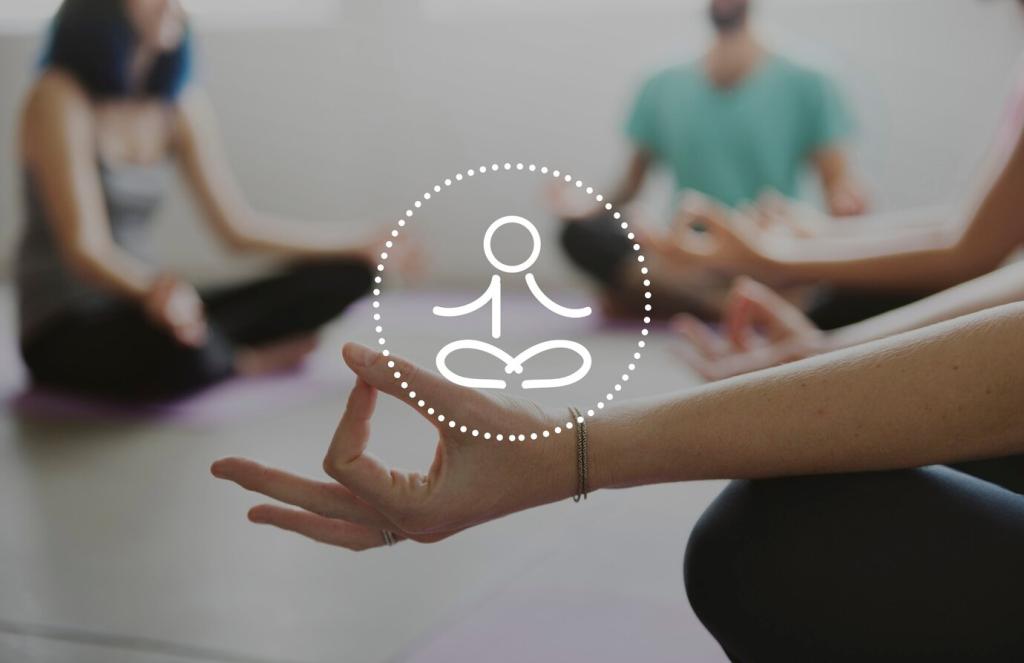Mindfulness Meditation for Workplace Stress: Breathe, Focus, Thrive
What Science Says About Mindfulness at Work
Workplace demands trigger the body’s stress response, elevating cortisol and tightening muscles. Regular mindfulness meditation interrupts this loop by training awareness of breath and sensations, encouraging parasympathetic recovery. Studies of eight-week mindfulness programs show reductions in perceived stress and improved sleep quality, which together translate into steadier energy through the day.


What Science Says About Mindfulness at Work
Mindfulness practice strengthens attention by gently returning the mind to a chosen anchor, like breathing. Over time, this reduces unhelpful rumination and improves working memory, especially during rapid task switching. Teams report fewer errors and clearer priorities because people notice distractions sooner, reset deliberately, and choose the next most important action with less internal noise.


A 5-Minute Desk Meditation You Can Start Today
Sit upright with feet on the floor, shoulders relaxed, and hands resting softly. If possible, silence notifications for five minutes. Let your gaze be gentle or close your eyes. Decide on a simple intention: to notice the breath and return kindly whenever the mind wanders, especially when work pressure tries to hijack your attention.
A 5-Minute Desk Meditation You Can Start Today
Inhale slowly through the nose for a count of four, feeling the belly expand. Pause briefly, then exhale for a count of six, softening the jaw and shoulders. Track ten cycles. Each time thoughts intrude—deadlines, emails, worries—label them “thinking,” and escort attention back to the next breath. This simple reset steadies nervous system arousal during stressful moments.
Building Mindful Micro-Breaks into Busy Schedules
Turn existing meetings into prompts. Add a one-minute breathing buffer before and after each call. Label it “Micro-pause: breathe.” Protect lunch like any high-value appointment. When the reminder pops up, practice three slow breaths and name your next priority. Comment with your favorite cue, and we’ll compile a community list of reminders that actually survive busy days.

Navigating Difficult Emotions at Work with Compassion
Recognize what is happening, Allow it to be there, Investigate sensations kindly, and Nurture with supportive words. In a tense moment, whisper internally, “This is stress; I can allow a breath.” Scan jaw, chest, and stomach, soften each on the exhale. This two-minute sequence transforms reactivity into choice, especially before presenting or giving tough feedback.
Navigating Difficult Emotions at Work with Compassion
Silently label the emotion: “anxious,” “angry,” or “overwhelmed.” Research shows accurate labeling calms the amygdala and increases self-regulation. Pair the label with breath counting: in four, out six. Then ask, “What matters most in the next ten minutes?” Prioritizing one meaningful step reduces emotional load while keeping momentum during stressful work cycles.

The 3-Breath Pause Before You Reply
Before answering a tough question, take three slow breaths. Notice impulse, soften the body, and choose a helpful intention like “clarify, not defend.” This tiny delay reduces reactive tone and improves outcomes in difficult conversations. Try it during your next stand-up, and tell us whether your reply felt calmer, clearer, and more aligned with team goals.
Listening for Needs, Not Just Words
While a colleague speaks, track your breath and notice their underlying need—clarity, progress, or reassurance. Reflect back a brief summary, then ask one open question. Mindful listening signals respect, lowers stress, and accelerates alignment. Practice with a teammate today and comment about what changed in the conversation’s energy when you focused on needs.
Email Mindfulness
Draft stressful emails, then pause for one breath before sending. Trim emotional language, add a clear subject, and specify the single next action. Consider whether an honest phone call might resolve tension faster. This mindful approach prevents late-night rumination and preserves relationships. Share your favorite calming subject line formulas that keep projects moving without friction.

Designing a Mindful Workspace
Light, Air, and Posture
Position your screen to reduce glare, breathe fresh air if possible, and adjust your chair so feet rest flat. Each hour, roll shoulders and unclench the jaw. Clearing visual clutter reduces cognitive load while mindful posture cues your brain for alert calm. Share a photo of your mindful setup and inspire someone to refresh their workspace today.
Noise and Notification Hygiene
Choose one notification window per hour instead of constant pings. Use ambient sound or noise-canceling headphones to soften chatter. Before high-focus work, set a 25-minute timer and silence everything else. This protects deep attention, which is especially fragile under stress. Comment with your favorite soundscapes for mindful concentration during demanding tasks and creative sprints.
Plants and Personal Symbols
Add a plant, a calm image, or a small object that reminds you to breathe. Each time you notice it, take one slow exhale. Personal anchors make mindfulness visible and effortless, especially during tense deadlines. What’s your anchor item? Tell us below, and we’ll feature creative ideas that bring a little nature and kindness to the desk.
A Story: The Project Manager Who Stopped Spinning
Chaos Before Change
Maya managed three projects and slept poorly, checking emails at midnight. She felt her chest tighten before status calls and snapped at a teammate over a minor delay. After a health scare, she committed to five daily mindful breaths before every meeting, treating them like tiny lifelines rather than luxuries she could postpone again.
Small Rituals, Big Shifts
Within two weeks, Maya used the 3-breath pause and labeled emotions during tense moments. She redesigned her desk, silenced notifications, and walked mindfully to refill water. Her team noticed fewer reactive emails and clearer priorities. Deadlines still existed, but her nervous system stopped sprinting all day. Performance improved without the old exhaustion spiral.
Continuing the Journey Together
Maya started a weekly five-minute group meditation before sprint planning, inviting anyone curious to join. Participation grew because the practice felt practical and respectful of time. Try this with your team and report back on your experience. Subscribe for new workplace mindfulness experiments, and share your story so others can learn from your real-world wins.

